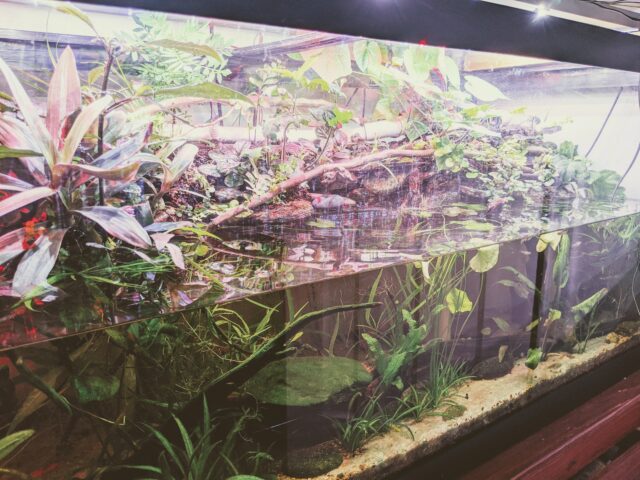I’ve had a 36 Gallon aquarium set up for nearly a year. Its been interesting to watch it develop over time. It is now fairly lush, with thriving plants and healthy fish. There were a few ups and downs as the aquarium came into its adolescent stage. Algae has been an issue and at least one outbreak of an unknown fish disease.

As the tank started gaining momentum, as evidenced by the plant growth and low readings during water testing, I noticed that the pH was reading higher than normal. Usually, my tap water comes in around 7.3 or 7.4, but I was testing my tank and getting results around 8.
Since the tank had been settling into a groove, I was puzzled about the pH spike. I didn’t have anymore evaporation than normal, my tap water was the same it had always been, no new rocks or other potential sources of minerals that might harden the water.
The answer that seems most compelling was one I found while combing through Diana Walstad’s incredible book The Ecology of the Planted Aquarium. She consistently makes the point that the limiting factor for aquatic plant is the availability of dissolved Carbon Dioxide. She then gives the example of a mid sized pond or small lake with aquatic plants:
When there is a enough light to trigger photosynthesis, the plants begin to consume and deplete the available Co2. Despite there still being sunlight available, photosynthesis is halted by the lack of Co2. The carbon dioxide won’t be replenished until the sun sets and stop any possible plant growth. Fish respiration, bacteria, decomposing organics and the natural infusion from the atmosphere will contribute to a store of Co2 overnight until the sunlight once again triggers photosynthesis which begins the consumption of the stored Co2.
Since Co2 has an acidifying effect on the water, it lowers the pH of the solution.
pH is a measure of the concentration of hydrogen ions [H+] in solution. pH is actually a logarithmic measure (-log[H+]). This formula has two implications. First, it means that the hydrogen ion concentration increases (thus the solution becomes more acidic) as the pH number decreases. Second, each time the pH is reduced by 1, the concentration of hydrogen ions increases by a factor of 10.
https://aquariumplants.com/getting-your-co2-levels-right-goes-over-the-kh-ph-co2-relationship-myths-and-facts/

I started thinking about it – I had been pretty consistently doing my water testing late in the day or in the evening. If the plants were consuming all of the Co2 mid way through the day, the pH would be at its highest point.
I tested my water the next morning, just as the lights were coming on. The pH registered at 7.2, which is lower than my tap water. The carbon dioxide from respiration and decomposing organic matter had lowered the pH nearly a full point.
When I thought about what was happening I was struck with the thought that the tank was breathing in a way. It wasn’t the breath of a single organism, but the daily cycle of the ecosystem within the tank.
When people talk of a cycled tank – they seem to only really be referring to the nitrogen cycle (which is obviously a good marker of when it is reasonably safe for inhabitants), but I would argue that the next stage in the development of a tank’s maturity is this state of daily breathing such that it can support vigorous plant growth, healthy fish and relatively low algae levels with minimal maintenance.

